In this article: read the review of Scythe – a board game, set in an alternate reality Eastern Europe with giant mechs controlling the rural land.
How does it play? Is it any good? What about expansions and digital editions? All that in my Scythe board game review.
Welcome to Diesel-Punk 1920s Eastern Europe
Scythe is set in an alternate reality in Eastern Europe, just after The Great War.
People are trying to recover and rebuild, but peace is not yet destined to happen. Cold war looms over the region as factions fight over land and resources with war leftovers – giant mechs stomping the rural land.
Scythe was created by Jamey Stegmaier in 2016 after a very successful Kickstarter campaign. It is based on the world and art built by Jakub Rozalski. Theme, setting, and artwork are some of the stars of the game, as Rozalski’s artistic style shines in all elements of the game: the board, cards, mechs, and miniatures.
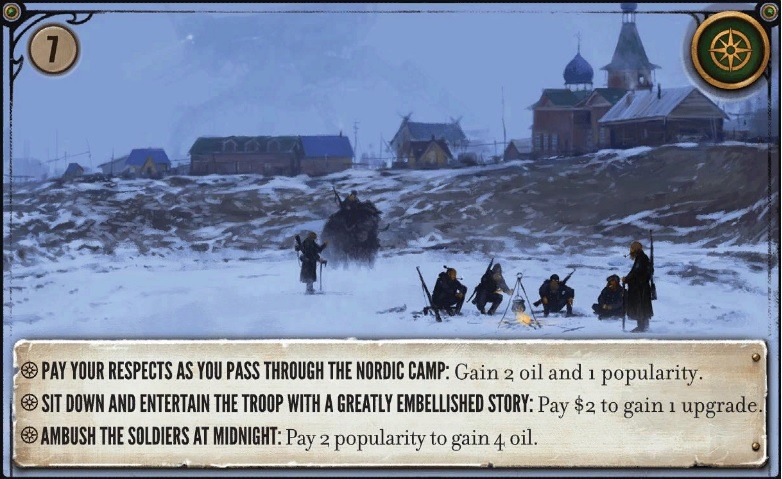
Introduction to Scythe – Board Game Review
Players: 1-5
Playing time: about two hours
Ages: 14 and up
Complexity: medium-high
BoardGameGeek: link
What is in the Box?
Scythe is a complex game with a large repertoire of resources, coins, tokens, structures, cards, and miniatures. In total, there are several hundred individual pieces in the box, many are faction specific.
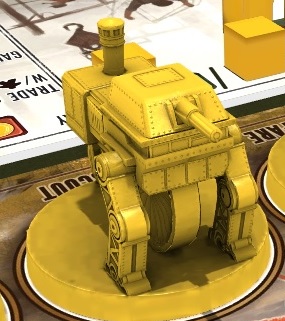
There are 5 factions in the base game, each of them with a uniquely designed main character, workers, and mechs: Rusviet Union, Crimean Khanate, Nordic Kingdom, Polania Republic, and Saxony Empire. Every faction has a special ability (or two) which makes them all unique to play.
You can read more about the factions and their faction-specific strategies here.
Setting up the Game
Each player receives a randomly selected faction mat which starts in a predefined location on the game board. Faction mats determine factions’ special abilities, their starting power, and starting combat cards.
Variety is added with (also randomly selected) player mats which tell you what actions (like building, producing, trading, and moving) and at what cost you will have during the game. They also set your starting coins, popularity, objective cards, and starting order. Although you can do all four actions with all the mats, some provide bonuses for certain actions.
Your main character miniature is placed on the starting point on the board with your two workers on the tiles adjacent.
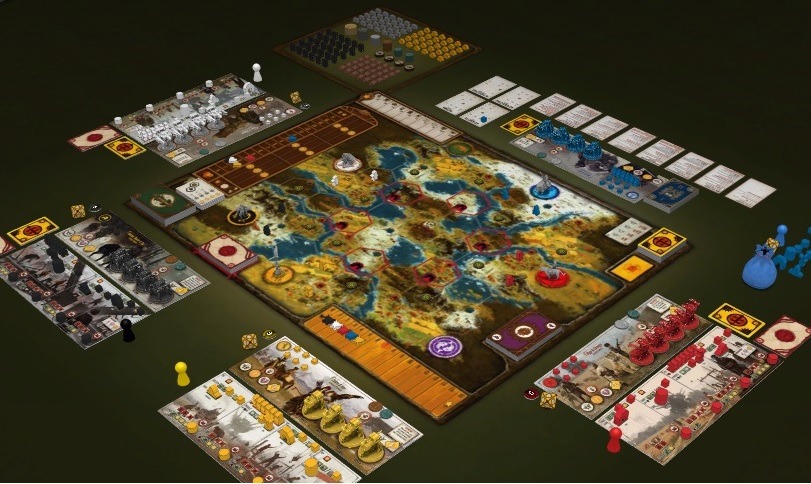
How to play Scythe?
On his turn, a player chooses one of four action sections on his player mat. This will be his action for the turn. Each action has two rows: top and bottom, with the top one being performed first.
The trick here is that every action costs something (resources, coins, popularity, or power), and gives you something else (produces resources, workers, grants movement, coins, cards, popularity, or power).
Top actions are cheap and basic (like moving and producing), but bottom actions are more advanced and require more resources to perform. You can (and you should plan your moves that you’ll be able to) perform both rows (if you can afford the bottom row), just one, or neither.
Top 10 Strategy Board Games for Adults
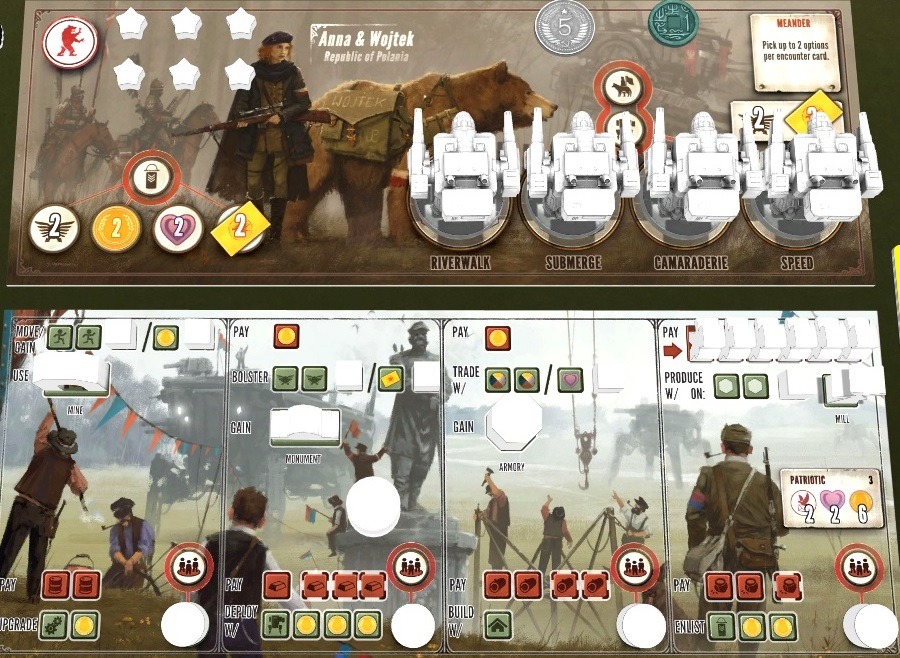
Indeed, during the early turns, you will mostly be moving and producing resources. Moving can be further upgraded several times.
Producing is tightly bound to how many workers you have (you can increase that by “producing” more workers in villages) and the produced resources stay on the board until they are spent. That means that you have to protect them since they can be captured by other players. There are five (tile-specific) different resources: food, wood, metal, oil, and workers.
(This concept of resources staying on the board and being potentially available to everyone is also one of the main features of Brass: Birmingham.)
After you have acquired enough resources, you can start building up your faction by:
- deploying mechs (which unlocks more special abilities: moving over rivers, moving through lakes or tunnels, etc),
- building structures (which give extra bonuses every time you play corresponding action on your player mat: resources, power, popularity, or mine-to-mine movement),
- upgrading your player mat: pay less to trade more resources or power, produce on more tiles, make it cheaper to deploy mechs,
- enlist soldiers to get extra popularity, coins, power, or combat cards immediately + every time your neighboring player does the same.
When the first player is completing the bottom row action, the next player can already start planning his top row action, keeping the gameplay smooth.
Mech versus Mech Combat
There is player-versus-player combat involved, but it is usually best to stay out of it (unless you can guarantee a win) since even a single defeat can be very costly.
The meeples you had on the losing tile are sent back to your starting location and any resources are captured by the victor. In a tight game, such a setback can quickly seal your fate.
Players tend to keep to themselves (and in true cold-war fashion form informal alliances) and focus on building up their faction.
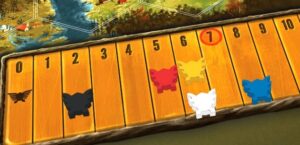
But sooner or later (especially when contesting the lucrative Factory tile at the center of the map with its extra bonuses) the inevitable happens and players collide.
The game uses a very clever combat system, eliminating the luck factor. Each player decides in secrecy how much of his power will he use (that can be further increased with combat cards for each mech or character involved). Use too little and you will lose the fight, use too much and you will be left very vulnerable to other players in subsequent turns.
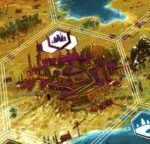
Random Encounters of the Eastern-European Kind
The only element of luck (besides starting mats) in Scythe is presented through encounter cards, which you capture by exploring marked tiles on the board. These cards are a work of art by themselves, each picturing a unique scenario: you run upon forest workers, into a festival, a lonely farmer.
Under the picture you have 3 choices on how to react, each giving or taking something from you (i.e. steal the wood from workers to gain resources and lose popularity). The positives outweigh the negatives (if you choose wisely).
That means encounter cards give you free stuff and encourage you to explore and upgrade your movement abilities. Moreover, encounter cards help you immerse into the theme.
As you can see, all this combined makes a very deep and complex game, full of choices, different things to do, and ways to interact with the board.
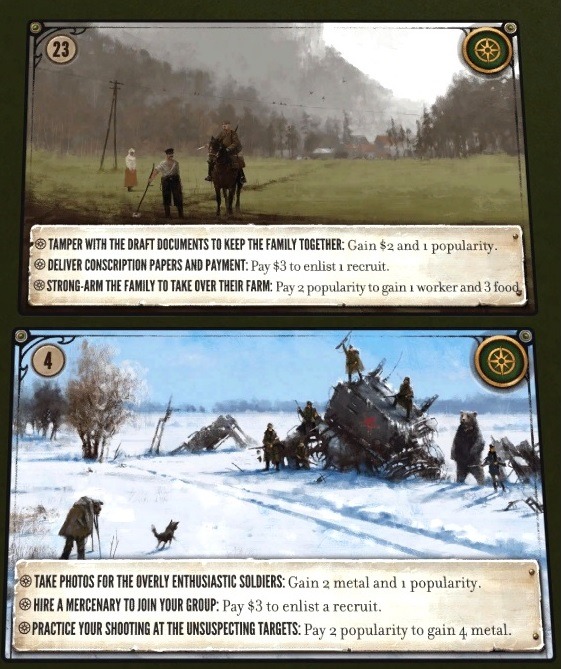
Being Popular Gets You Money, Money Wins Games
We’ve seen how the game is played, now let’s look at where this all is leading. The goal of the game is to be the wealthiest faction in Eastern Europe.
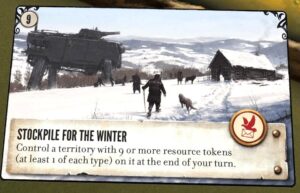
You can start accumulating wealth during the game, but most of it will fall to your hands after the game has ended and scores have been calculated.
At the game setup, each player received 6 stars, which are a tool to keep track of special achievements:
- complete all 6 upgrades,
- deploy all 4 mechs,
- build all 4 structures,
- enlist all 4 recruits,
- have all 8 workers on the board,
- reveal 1 completed objective card,
- win combat (up to 2 times),
- have 18 popularity and
- have 16 power.

If you’re interested to see how things work out in practice, check out my article on Strategy and tips for getting better at Scythe.
End-game Scoring
Every time a player completes one of these achievements, he places a star on a special table, and when the first player places six stars, gameplay ends immediately.
But that does not mean, that this player is also the winner (although he gets more coins for his stars, thus making him one of the favorites), it only means that the scoring can now begin.

Games are usually tight, so it’s not going to be like one player having 5 stars up and the other having none.
More often than not, you are trying to frantically maximize your points by expanding and boosting your popularity as players try to reach for that final star. That leads to some very tight and tense end play.
Now we can start counting the money:
- coins in hand, stars,
- territories controlled,
- resources controlled and
- structure bonus tile (what that bonus will be is randomly determined pregame: extra points for structures near lakes, near encounter tiles, near tunnels, etc).
Popularity kicks in – it works as a multiplier for stars, tiles, and resources and it can yield a lot of coins. It makes sense I guess – after all, to be a winner, you’ve got to earn the love of the masses.
Expansions
- Invaders from Afar (2016) is the first expansion for Scythe. It adds two new factions, both very specialized and challenging to play. You can read my review of Invaders from Afar here.
- The Wind Gambit (2017) adds Airships and Resolutions. An airship is a new type of unit that flies above the map. Resolutions alter end-game conditions.
- The Rise of Fenris introduces a story-driven eight-episode campaign. It’s especially recommendable if you plan to play Scythe solo.
- Encounters is a pack of 32 fan-designed new encounter cards.
Opinion and Recommendation
Scythe is not a family-friendly pick-up-and-play game (unless your family is full of geeks – in that case, congratulations). Its target audience is more advanced board gamers, gamers that will take their time to explore the differences between the factions and how to exploit them best.
With all the things in the box, it’s no surprise that the price is also a bit higher, even though the creators tried to keep it down with cardboard tokens and plastic miniatures. Metal ones can be ordered as an upgrade, as well as the larger board.
Game mechanics and rules can be overwhelming at the beginning, but I found them very intuitive and easy to understand after a game or two. Some practice is required and one of the best ways to practice is through the Digital Edition.
If you have a group of friends, that you play together regularly, this is a great addition to your library. With a special Automa ruleset (included in the base game), you can even play single-player and enjoy it on your own.
Do you like what you just read? Consider subscribing for more content:
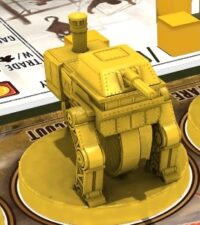

Interesting game. It’s like taking your traditional strategy games on the PC/console and putting it in a board game. For those who are into board games, or even card games, this look like a fun game to advance to. I can imagine playing this with a bunch of friends over beer too!
It draws a lot of ideas from 4X PC games like Civilization, you are right. try the Digital Edition of Scythe, if you’re more into computer games than board games
A well done description of the game Scythe! I’m not the biggest fan of board games per se but the way you break down the elements of the game and even provide insight relating to the strategy of engaging other players in game was intriguing. I may have to check this out. Good stuff!
Thanks for the comment, I’m glad you enjoyed reading!
This is very good honestly, I like that one gets the ability to build his own mechs. Sounds like a game that would need a lot of tactics. I have a group of friends whom we play board games together but we stopped a while a go. I should try scythe, I like how you have complemented your explanation with pictures. It didn’t look like a board game to me at first. I’ll definitely get this. Thank you for a good review
It would be perfect for you and your friends!